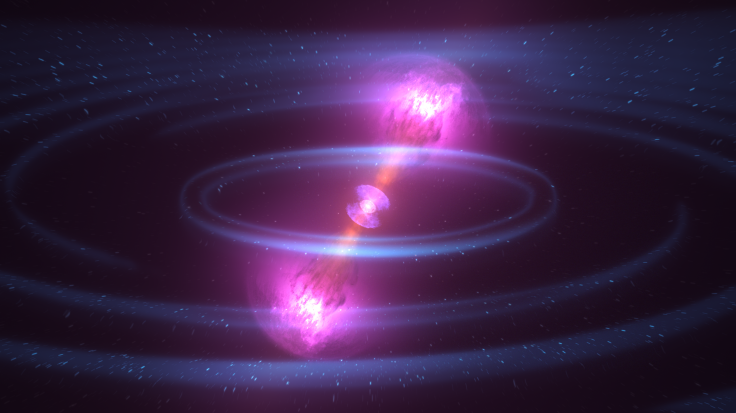Neutron Star Mergers Cause Short Gamma-Ray Bursts, Study Confirms

Gamma-ray bursts, aka GRBs, are one of the most powerful events known to occur in the entire universe. These intense explosions, which release narrow beams of electromagnetic radiation, have been observed in distant galaxies and can release sun’s entire life’s energy in a matter of few seconds. Scientists have been studying these events for years and just recently, a group of scientists confirmed that the merger between two neutron stars — smallest, densest stars — results in short GRBs.
GRBs are classified into two main categories on the basis of their duration — long and short term. The former, which could last from a couple of seconds to several minutes, follows the death of a massive star when its core turns into a black hole, while the latter lasts just up to two seconds and is thought to have been associated with the merger of two neutron stars.
Neutron stars form when the core of a massive star undergoes gravitational collapse at the end of its life and cram as much as twice the mass of our sun in a sphere measuring 20 km across. A merger between two such stars, an event popularly known as Kilonova, was witnessed last year when scientists at the LIGO and Virgo observatories detected gravitational waves — ripples in the fabric of space and time — coinciding with a gamma-ray burst.
The detection bolstered the theory that short-spanning electromagnetic radiation originated from neutron star mergers, but one thing remained unclear — whether the detected rays were short gamma-ray bursts or a secondary, much weaker emission.
“We argued that the interaction of the short gamma-ray burst jet with its surroundings creates a secondary source of emission called the cocoon,” Davide Lazzati, the lead author of the study, said in a statement. “The cocoon is much weaker than the main beam and is undetectable if the main beam points toward our instruments. However, it could be detected for nearby bursts whose beam points away from us.”
That said, in order to delve into the phenomenon, the group continued the observation of the location in which gravitational waves were detected. Last year, the researcher’s team had posited that short GRBs associated with neutron star mergers could be detected even if the burst is not pointing toward Earth and the latest work proved the theory. They detected gamma-ray burst which was followed by another set of radiation in the form of gamma and X-ray. However, the secondary radiation was different from the typical short GRBs.
“Usually there’s a short burst, a bright pulse, bright X-ray radiation, then it decays with time,” Lazzati said in the statement. “This one had a weak gamma-ray pulse, and the afterglow was faint, brightened very quickly, kept brightening, [and] then turned off.”
“But that behavior is expected when you’re seeing it from an off-axis observation point when you’re not staring down the barrel of the jet,” he added. “This is doing exactly what we expected an off-axis jet would do and is convincing proof that binary neutron star mergers and short gamma-ray bursts are indeed related to each other.”
The group believes the findings are an important step toward understanding the connection between neutron star mergers, gravitational waves, and short gamma-ray bursts.
© Copyright IBTimes 2025. All rights reserved.





















